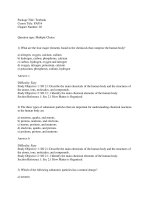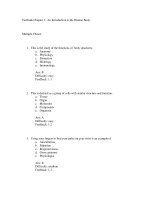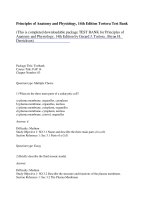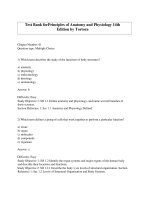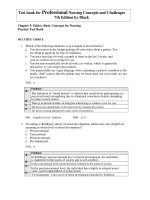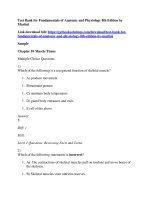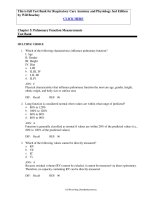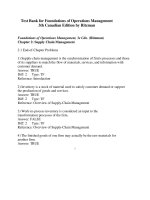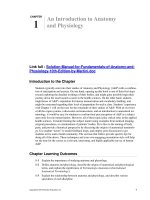Test bank for principles of anatomy and physiology 14th edition by tortora download
Bạn đang xem bản rút gọn của tài liệu. Xem và tải ngay bản đầy đủ của tài liệu tại đây (594.25 KB, 43 trang )
Test Bank forPrinciples of Anatomy and Physiology 14th
Edition by Tortora
Chapter Number: 01
Question type: Multiple Choice
1) Which term describes the study of the functions of body structures?
a) anatomy
b) physiology
c) endocrinology
d) histology
e) immunology
Answer: b
Difficulty: Easy
Study Objective 1: SO 1.1 Define anatomy and physiology, and name several branches of
these sciences.
Section Reference 1: Sec 1.1 Anatomy and Physiology Defined
2) Which term defines a group of cells that work together to perform a particular function?
a) tissue
b) organ
c) molecules
d) compounds
e) organism
Answer: a
Difficulty: Easy
Study Objective 1: SO 1.2 Identify the organ systems and major organs of the human body
and describe their locations and functions.
Study Objective 2: SO 1.2.1 Describe the body’s six levels of structural organization. Section
Reference 1: Sec 1.2 Levels of Structural Organization and Body Systems.
3) Which term refers to the sum of all chemical processes that occur in the body?
a) metabolism
b) anabolism
c) catabolism
d) auscultation
e) palpation
Answer: a
Difficulty: Easy
Study Objective 1: SO 1.3.1 Define the important life processes of the human body. Section
Reference 1: Sec 1.3 Characteristics of the Living Human Organism
Question type: Essay
4) List the basic processes of life.
Answer:
Difficulty: Medium
Study Objective 1: SO 1.3.1 Define the important life processes of the human body.
Section Reference 1: Sec 1.3 Characteristics of the Living Human Organism
Solution: The basic processes of life include metabolism, responsiveness, movement,
growth, differentiation and reproduction.
Question type: Multiple Choice
5) The two organ systems that regulate and maintain homeostasis are the
a) cardiovascular and integumentary systems.
b) nervous and endocrine systems.
c) cardiovascular and respiratory systems.
d) respiratory and muscular systems.
e) urinary and integumentary systems.
Answer: b
Difficulty: Easy
Study Objective 1: SO 1.4 Understand the importance of homeostatic feedback systems and
how imbalances are related to disorders.
Study Objective 2: SO 1.4.1 Define homeostasis.
Section Reference 1: Sec 1.4 Homeostasis
6) Which body fluid fills the narrow spaces between cells and tissues and directly affects
the proper functioning of cells?
a) lymph
b) blood plasma
c) interstitial fluid
d) intracellular fluid
e) vitreous body
Answer: c
Difficulty: Medium
Study Objective 1: SO 1.3 Define the important processes of the human body.
Study Objective 2: SO 1.3.2 Define homeostasis and explain its relationship to interstitial fluid.
Section Reference 1: Sec 1.3 Characteristics of the Living Human Organism
Question type: Essay
7) Describe the differences between positive and negative feedback systems.
Answer:
Difficulty: Medium
Study Objective 1: SO 1.4 Understand the importance of homeostatic feedback systems and
how imbalances are related to disorders.
Study Objective 2: SO 1.4.3 Contrast the operation of negative and positive feedback systems.
Section Reference 1: Sec 1.4 Homeostasis
Solution: A positive feedback system will strengthen or reinforce a change in one of the
body’s controlled conditions while a negative feedback system will reverse a change in a
controlled condition.
Question type: Multiple Choice
8) Which feedback system structure receives output from the control center?
a) receptor
b) stimulus
c) response
d) effector
e) efferent pathway
Answer: d
Difficulty: Medium
Study Objective 1: SO 1.4 Understand the importance of homeostatic feedback systems and
how imbalances are related to disorders.
Study Objective 2: SO 1.4.2 Describe the components of a feedback system. Section
Reference 1: Sec 1.4 Homeostasis
9) Which feedback system structure provides input to the control center?
a) receptor
b) muscle
c) response
d) effector
e) efferent pathway
Answer: a
Difficulty: Medium
Study Objective 1: SO 1.4 Understand the importance of homeostatic feedback systems and
how imbalances are related to disorders.
Study Objective 2: SO 1.4.2 Describe the components of a feedback system. Section
Reference 1: Sec 1.4 Homeostasis
10) A condition NOT regulated by a negative feedback loop would be:
a) childbirth
b) body temperature
c) blood pressure
d) heart rate
e) blood sugar
Answer: a
Difficulty: Medium
Study Objective 1: SO 1.4 Understand the importance of homeostatic feedback systems and
how imbalances are related to disorders.
Study Objective 2: SO 1.4.3 Contrast the operation of negative and positive feedback systems.
Section Reference 1: Sec 1.4 Homeostasis
11) Objective changes in a patient’s normal body function that can be directly observed
or measured by a clinician are referred to as
a) symptoms.
b) disorders.
c) disturbance.
d) diseases
e) signs.
Answer: e
Difficulty: Medium
Study Objective 1: SO 1.4 Understand the importance of homeostatic feedback systems and
how imbalances are related to disorders.
Study Objective 2: SO 1.4.4 Explain how homeostatic imbalances are related to disorders
Section Reference 1: Sec 1.4 Homeostasis
Question type: Essay
12) Describe the anatomical position.
Answer:
Difficulty: Medium
Study Objective 1: SO 1.5 Describe the human body using the anatomical position and
specific anatomical terminology.
Study Objective 2: SO 1.5.1 Describe the anatomical position.
Section Reference 1: Sec 1.5 Basic Anatomical Terminology
Solution: In the anatomical position, the subject stands erect facing the observer with the
head level and the eyes facing forward. The feet are flat on the floor and directed forward and
the arms are at the sides with the palms turned forward.
Question type: Multiple Choice
13) The lungs are located in the
a) cranial cavity.
b) vertebral cavity.
c) abdominal cavity.
d) pericardial cavity.
e) pleural cavity.
Answer: e
Difficulty: Easy
Study Objective 1: SO 1.5 Describe the human body using the anatomical position and
specific anatomical terminology.
Study Objective 2: SO 1.5.4 Outline the major body cavities, the organs they contain, and
their associated linings.
Section Reference 1: Sec 1.5 Basic Anatomical Terminology
14) Which cavity is located inferior to the abdominal cavity?
a) vertebral canal
b) cranial cavity
c) abdominal cavity
d) pericardial cavity
e) pelvic cavity
Answer: e
Difficulty: Medium
Study Objective 1: SO 1.5 Describe the human body using the anatomical position and
specific anatomical terminology.
Study Objective 2: SO 1.5.4 Outline the major body cavities, the organs they contain, and
their associated linings.
Section Reference 1: Sec 1.5 Basic Anatomical Terminology
15) Which cavity contains the heart?
a) cranial cavity
b) vertebral cavity
c) abdominal cavity
d) pericardial cavity
e) pleural cavity
Answer: d
Difficulty: Easy
Study Objective 1: SO 1.5 Describe the human body using the anatomical position and
specific anatomical terminology.
Study Objective 2: SO 1.5.4 Outline the major body cavities, the organs they contain, and
their associated linings.
Section Reference 1: Sec 1.5 Basic Anatomical Terminology
16) The function of the secretions of a serous membrane, like the pleura, is to
a) separate the thoracic and abdominal cavities.
b) protect the central nervous system.
c) prevent infection.
d) reduce friction between neighboring organs.
e) carry nervous impulses.
Answer: d
Difficulty: Medium
Study Objective 1: SO 1.5 Describe the human body using the anatomical position and
specific anatomical terminology.
Study Objective 2: SO 1.5.4 Outline the major body cavities, the organs they contain, and
their associated linings.
Section Reference 1: Sec 1.5 Basic Anatomical Terminology
17) Which plane divides the body into equal right and left halves?
a) frontal
b) midsagittal
c) transverse
d) oblique
e) coronal
Answer: b
Difficulty: Medium
Study Objective 1: SO 1.5 Describe the human body using the anatomical position and
specific anatomical terminology.
Study Objective 2: SO 1.5.3 Define the anatomical planes, anatomical sections, and
directional terms used to describe the human body.
Section Reference 1: Sec 1.5 Basic Anatomical Terminology
18) Which plane divides the body into anterior and posterior portions?
a) frontal
b) sagittal
c) transverse
d) oblique
e) midsagittal
Answer: a
Difficulty: Medium
Study Objective 1: SO 1.5 Describe the human body using the anatomical position and
specific anatomical terminology.
Study Objective 2: SO 1.5.3 Define the anatomical planes, anatomical sections, and
directional terms used to describe the human body.
Section Reference 1: Sec 1.5 Basic Anatomical Terminology
19) A transverse plane will cut a body or organ into
a) anterior and posterior portions.
b) left and right portions.
c) superior and inferior portions.
d) portions separated at an angle to its longitudinal axis.
e) unequal left and right portions.
Answer: c
Difficulty: Medium
Study Objective 1: SO 1.5 Describe the human body using the anatomical position and
specific anatomical terminology.
Study Objective 2: SO 1.5.3 Define the anatomical planes, anatomical sections, and
directional terms used to describe the human body.
Section Reference 1: Sec 1.5 Basic Anatomical Terminology
20) Which directional term means farther from the midline?
a) medial
b) anterior
c) proximal
d) deep
e) lateral
Answer: e
Difficulty: Medium
Study Objective 1: SO 1.5 Describe the human body using the anatomical position and
specific anatomical terminology.
Study Objective 2: SO 1.5.3 Define the anatomical planes, anatomical sections, and
directional terms used to describe the human body.
Section Reference 1: Sec 1.5 Basic Anatomical Terminology
21) Which directional term means farther from the attachment of a limb to the trunk or
farther from the origination of a structure?
a) deep
b) contralateral
c) lateral
d) cephalic
e) distal
Answer: e
Difficulty: Medium
Study Objective 1: SO 1.5 Describe the human body using the anatomical position and
specific anatomical terminology.
Study Objective 2: SO 1.5.3 Define the anatomical planes, anatomical sections, and
directional terms used to describe the human body.
Section Reference 1: Sec 1.5 Basic Anatomical Terminology
22) Choose the directional term that would make the following sentence correct. The heart is
_____ to the liver.
a) inferior
b) anterior
c) contralateral
d) superior
e) superficial
Answer: d
Difficulty: Medium
Study Objective 1: SO 1.5 Describe the human body using the anatomical position and
specific anatomical terminology.
Study Objective 2: SO 1.5.3 Define the anatomical planes, anatomical sections, and
directional terms used to describe the human body.
Section Reference 1: Sec 1.5 Basic Anatomical Terminology
23) Choose the directional term that would make the following sentence correct. The sternum is
_____ to the heart.
a) posterior
b) anterior
c) inferior
d) superior
e) lateral
Answer: b
Difficulty: Medium
Study Objective 1: SO 1.5 Describe the human body using the anatomical position and
specific anatomical terminology.
Study Objective 2: SO 1.5.3 Define the anatomical planes, anatomical sections, and
directional terms used to describe the human body.
Section Reference 1: Sec 1.5 Basic Anatomical Terminology
24) Which of the following organs is not found in the abdominal cavity?
a) stomach
b) spleen
c) liver
d) gallbladder
e) diaphragm
Answer: e
Difficulty: Medium
Study Objective 1: SO 1.5 Describe the human body using the anatomical position and
specific anatomical terminology.
Study Objective 2: SO 1.5.4 Outline the major body cavities, the organs they contain, and
their associated linings.
Section Reference 1: Sec 1.5 Basic Anatomical Terminology
25) Which serous membrane covers the viscera within the abdominal cavity, and lines
the abdominal wall and the inferior surface of the diaphragm?
a) pericardium
b) pleura
c) mediastinum
d) dura mater
e) peritoneum
Answer: e
Difficulty: Medium
Study Objective 1: SO 1.5 Describe the human body using the anatomical position and
specific anatomical terminology.
Study Objective 2: SO 1.5.4 Outline the major body cavities, the organs they contain, and
their associated linings.
Section Reference 1: Sec 1.5 Basic Anatomical Terminology
26) Where on the diagram is the femoral area?
a) D
b) E
c) F
d) J
e) K
Answer: a
Difficulty: Medium
Study Objective 1: SO 1.5 Describe the human body using the anatomical position and
specific anatomical terminology.
Study Objective 2: SO 1.5.3 Define the anatomical planes, anatomical sections, and
directional terms used to describe the human body.
Section Reference 1: Sec 1.5 Basic Anatomical Terminology
27) Where on the diagram is the cervical area?
a) C
b) E
c) J
d) K
e) B
Answer: e
Difficulty: Medium
Study Objective 1: SO 1.5 Describe the human body using the anatomical position and
specific anatomical terminology.
Study Objective 2: SO 1.5.3 Define the anatomical planes, anatomical sections, and
directional terms used to describe the human body.
Section Reference 1: Sec 1.5 Basic Anatomical Terminology
28) The ribs are _____ to the sternum.
a) lateral
b) medial
c) proximal
d) distal
e) superior
Answer: a
anatomical terminology.
Study Objective 2: SO 1.5.3 Define the anatomical planes, anatomical sections, and directional
terms used to describe the human body.
Section Reference 1: Sec 1.5 Basic Anatomical Terminology
Difficulty: Medium
Study Objective 1: SO 1.5 Describe the human body using the anatomical position and
specific 29) The stomach is _____ to the urinary bladder.
a) lateral
b) medial
c) distal
d) inferior
e) superior
anatomical terminology.
Study Objective 2: SO 1.5.3 Define the anatomical planes, anatomical sections, and directional
terms used to describe the human body.
Section Reference 1: Sec 1.5 Basic Anatomical Terminology
Answer: e
Difficulty: Medium
Study Objective 1: SO 1.5 Describe the human body using the anatomical position and
specific 30) Which plane is parasagittal?
a) A
b) B
c) C
d) D
anatomical terminology.
Study Objective 2: SO 1.5.3 Define the anatomical planes, anatomical sections, and directional
terms used to describe the human body.
Section Reference 1: Sec 1.5 Basic Anatomical Terminology
e) E
Answer: b
Difficulty: Medium
Study Objective 1: SO 1.5 Describe the human body using the anatomical position and specific
anatomical terminology.
Study Objective 2: SO 1.5.3 Define the anatomical planes, anatomical sections, and directional
terms used to describe the human body.
Section Reference 1: Sec 1.5 Basic Anatomical Terminology
31) Which plane is frontal?
a) A
b) B
c) C
d) D
e) E
Answer: e
Difficulty: Medium
Study Objective 1: SO 1.5 Describe the human body using the anatomical position and
specific anatomical terminology.
Study Objective 2: SO 1.5.3 Define the anatomical planes, anatomical sections, and
directional terms used to describe the human body.
Section Reference 1: Sec 1.5 Basic Anatomical Terminology
Question type: Essay
32) Name the cavities of the trunk and the serous membranes that line them.
Answer:
Difficulty: Medium
Study Objective 1: SO 1.5 Describe the human body using the anatomical position and
specific anatomical terminology.
Study Objective 2: SO 1.5.4 Outline the major body cavities, the organs they contain, and
their associated linings.
Section Reference 3: 1.5 Basic Anatomical Terminology
Solution: The two main cavities of the trunk are the thoracic and abdominopelvic cavities. The
thoracic cavity can be divided into three smaller cavities called the pericardial cavity, and two
fluid-filled spaces called pleural cavities. The pericardial cavity is lined by the pericardium.
The pleural cavity is lined by the pleura. The central part of the thoracic cavity is an anatomical
region called the mediastinum. It is between the lungs, extending from the sternum to the
vertebral column and from the first rib to the diaphragm. The abdominopelvic cavity can be
divided into the abdominal and pelvic cavities, both of which are lined by the peritoneum.
33) List the eleven organ systems of the human body.
Answer:
Difficulty: Medium
Study Objective 1: SO 1.2 Identify the organ systems and major organs of the human body
and describe their locations and functions.
Study Objective 2: SO 1.2.2 List the 11 systems of the human body, representative
organs present in each, and their general functions
Section Reference 1: Sec 1.2 Levels of Structural Organization body systems.
Solution: The eleven organ systems of the human body include the integumentary,
skeletal, muscular, nervous, digestive, urinary, respiratory, immune and lymphatic,
cardiovascular, endocrine, and reproductive systems.
34) Name the structural levels of the body and briefly describe each level.
Answer:
Difficulty: Hard
Study Objective 1: SO 1.2 Identify the organ systems and major organs of the human body
and describe their locations and functions
Study Objective 2: SO 1.2.1 Describe the body’s six levels of structural organization.
Section Reference 1: Sec 1.2 Levels of Structural Organization body systems.
Solution: The chemical level consists of atoms and molecules. The cellular level consists of
cells which are the smallest form of life. The tissue level consists of groups of cells that work to
provide a single function. The organ level consists of organs, constructed from different types of
tissue that can provide several different specific functions. The organ systems consist of one
or more organs that are interlinked in general functions. The organism is made up of all the
organ systems, which work to provide homeostasis.
35) List and briefly describe the six basic life processes.
Answer:
Difficulty: Hard
Study Objective 1: SO 1.3.1 Define the important life processes of the human body.
Section Reference 1: Sec 1.3 Characteristics of the Living Human Organism
Solution: The six basic life processes include: 1) Metabolism is the sum of all chemical
processes in the body. 2) Responsiveness is the body’s ability to detect and respond to internal
and external stimuli. 3) Movement includes motions that range from movements within
individual cells to movement of the entire body. 4) Growth means an increase in body size or an
increase in the number of cells. 5) Differentiation is the process that converts a cell from
unspecialized to specialized. 6) Reproduction refers to formation of new cells for growth and
repair or production of a new individual.
36) Describe a feedback system and list its general
components. Answer:
Difficulty: Medium
Study Objective 1: SO 1.4 Understand the importance of homeostatic feedback systems and
how imbalances are related to disorders.
Study Objective 2: SO 1.4.2 Describe the components of a feedback system
Section Reference 1: Sec 1.4 Homeostasis
Solution: A feedback loop is a cycle of events in which the status of the body condition is
monitored, evaluated and changed to maintain homeostasis. A feedback system will include
a receptor that detects the stimuli, a control center that receives the input from the receptor
and generates an output, and an effector that receives the output and produces a response.
Question type: Multiple Choice
37) Which of the following noninvasive diagnostic techniques is an example of inspection?
a) tapping and listening for an echo to detect fluid in the lungs
b) feeling the abdomen to detect tender organs
c) listening for crackling sounds during breathing
d) examining the surface of patient’s skin for presence of a rash
e) feeling the gonads to detect abnormal masses
Answer: d
Difficulty: Hard
Study Objective 1: SO 1.2 Identify the organ systems and major organs of the human body
and describe their locations and functions.
Study Objective 2: SO 1.2.2 List the 11 systems of the human body, representative
organs present in each, and their general functions.
Section Reference 1: Sec 1.2 Levels of Structural Organization body systems.
38) Which subspecialty of physiology deals with the study of the functional properties of
nerve cells?
a) endocrinology
b) cardiovascular physiology
c) neurophysiology
d) immunology
e) pathophysiology
Answer: c
Difficulty: Easy
Study Objective 1: SO 1.1 Define anatomy and physiology, and name several branches of
these sciences.
Section Reference 1: Sec 1.1 Anatomy and Physiology Defined
39) Which subspecialty of physiology deals with the study of the chemical regulators in the
blood?
a) endocrinology
b) cardiovascular physiology
c) neurophysiology
d) immunology
e) pathophysiology
Answer: a
Difficulty: Easy
Study Objective 1: SO 1.1 Define anatomy and physiology, and name several branches of
these sciences.
Section Reference 1: Sec 1.1 Anatomy and Physiology Defined
40) Which subspecialty of physiology deals with the study of functional changes associated
with disease and aging?
a) exercise physiology
b) renal physiology
c) pathophysiology
d) cardiovascular physiology
e) immunology
Answer: c
Difficulty: Easy
Study Objective 1: SO 1.1 Define anatomy and physiology, and name several branches of
these sciences.
Section Reference 1: Sec 1.1 Anatomy and Physiology Defined
41) Which subspecialty of physiology deals with the study of the body’s defense
against diseasecausing agents?
a) exercise physiology
b) renal physiology
c) pathophysiology
d) cardiovascular physiology
e) immunology
Answer: e
Difficulty: Easy
Study Objective 1: SO 1.1 Define anatomy and physiology, and name several branches of
these sciences.
Section Reference 1: Sec 1.1 Anatomy and Physiology Defined
42) Which subspecialty of anatomy deals with the study of structural changes associated
with disease?
a) embryology
b) developmental biology
c) radiographic anatomy
d) pathological anatomy
e) immunology
Answer: d
Difficulty: Medium
Study Objective 1: SO 1.1 Define anatomy and physiology, and name several branches of
these sciences.
Section Reference 1: Sec 1.1 Anatomy and Physiology Defined
43) Which of the following anatomical terms refers to the groin?
a) pelvic
b) umbilical
c) sternal
d) otic
e) inguinal
Answer: e
Difficulty: Medium
Study Objective 1: SO 1.5 Describe the human body using the anatomical position and
specific anatomical terminology.
Study Objective 2: SO 1.5.2 Relate the anatomical names and the corresponding common
names for various regions of the human body.
Section Reference 1: Sec 1.5 Basic Anatomical Terminology
44) Which of the following anatomical terms refers to the front of the elbow?
a) olecranal
b) antecubital
c) carpal
d) digital
e) antebrachial
Answer: b
Difficulty: Hard
Study Objective 1: SO 1.5 Describe the human body using the anatomical position and
specific anatomical terminology.
Study Objective 2: SO 1.5.2 Relate the anatomical names and the corresponding common
names for various regions of the human body.
Section Reference 1: Sec 1.5 Basic Anatomical Terminology
45) Which of the following anatomical terms refers to the ear?
a) otic
b) orbital
c) ocular
d) oral
e) occipital
Answer: a
Difficulty: Hard
Study Objective 1: SO 1.5 Describe the human body using the anatomical position and
specific anatomical terminology.
Study Objective 2: SO 1.5.2 Relate the anatomical names and the corresponding common
names for various regions of the human body.
Section Reference 1: Sec 1.5 Basic Anatomical Terminology
46) Which of the following anatomical terms refers to the great toe?
a) pollex
b) tarsal
c) hallux
d) pedal
e) carpal
Answer: c
Difficulty: Hard
Study Objective 1: SO 1.5 Describe the human body using the anatomical position and
specific anatomical terminology.
Study Objective 2: SO 1.5.2 Relate the anatomical names and the corresponding common
names for various regions of the human body.
Section Reference 1: Sec 1.5 Basic Anatomical Terminology
47) Which of the following anatomical terms refers to the thumb?
a) pollex
b) tarsal
c) hallux
d) volar
e) carpal
Answer: a
Difficulty: Hard
Study Objective 1: SO 1.5 Describe the human body using the anatomical position and
specific anatomical terminology.
Study Objective 2: SO 1.5.2 Relate the anatomical names and the corresponding common
names for various regions of the human body.
Section Reference 1: Sec 1.5 Basic Anatomical Terminology
48) The section shown in (c) results from cutting through a _____ plane extending through
the brain?
